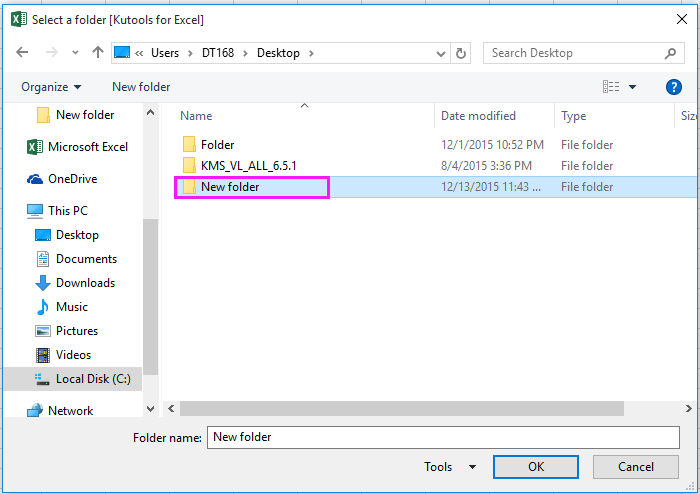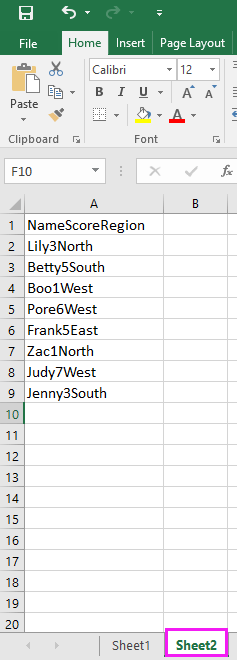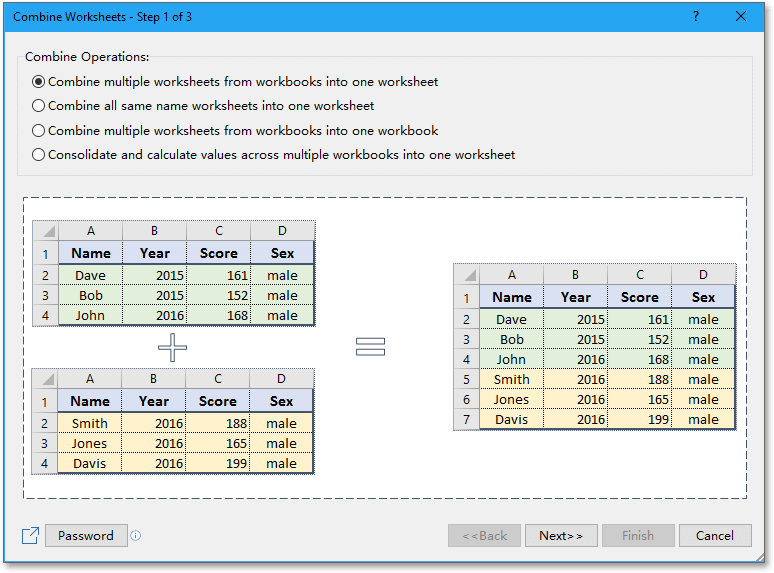Jak szybko importować wiele plików csv / text / xml w programie Excel?
W programie Excel być może zapisałeś skoroszyt jako plik csv, plik tekstowy lub plik xml, ale czy kiedykolwiek próbowałeś zaimportować wiele plików csv / text / xml z folderu do skoroszytu lub arkusza? W tym artykule przedstawię kilka metod szybkiego ich importowania wsadowego.
Importuj wiele plików tekstowych z folderu do każdego arkusza roboczego skoroszytu z VBA
Importuj wiele plików CSV z folderu do jednego arkusza za pomocą VBA
Zaimportuj wiele plików xml z folderu do jednego arkusza za pomocą VBA
Importuj lub łącz wiele plików xml / csv w arkusz lub skoroszyt za pomocą Kutools for Excel ![]()
Eksportuj każdy arkusz jako csv / text / pdf do folderu z Kutools for Excel![]()
Importuj wiele plików tekstowych z folderu do każdego arkusza roboczego skoroszytu z VBA
Aby zaimportować pliki tekstowe z folderu do skoroszytu, możesz użyć poniższego VBA, aby szybko sobie z tym poradzić.
1. Włącz pusty skoroszyt i naciśnij Alt + F11 klucze do otwarcia Microsoft Visual Basic for Applications okno.
2. kliknij wstawka > Modułi wklej VBA do Moduł okno.
VBA: Importuj wszystkie pliki tekstowe z folderu do skoroszytu
Sub LoadPipeDelimitedFiles()
'UpdatebyKutoolsforExcel20151214
Dim xStrPath As String
Dim xFileDialog As FileDialog
Dim xFile As String
Dim xCount As Long
On Error GoTo ErrHandler
Set xFileDialog = Application.FileDialog(msoFileDialogFolderPicker)
xFileDialog.AllowMultiSelect = False
xFileDialog.Title = "Select a folder [Kutools for Excel]"
If xFileDialog.Show = -1 Then
xStrPath = xFileDialog.SelectedItems(1)
End If
If xStrPath = "" Then Exit Sub
Application.ScreenUpdating = False
xFile = Dir(xStrPath & "\*.txt")
Do While xFile <> ""
xCount = xCount + 1
Sheets(xCount).Select
With ActiveSheet.QueryTables.Add(Connection:="TEXT;" _
& xStrPath & "\" & xFile, Destination:=Range("A1"))
.Name = "a" & xCount
.FieldNames = True
.RowNumbers = False
.FillAdjacentFormulas = False
.PreserveFormatting = True
.RefreshOnFileOpen = False
.RefreshStyle = xlInsertDeleteCells
.SavePassword = False
.SaveData = True
.AdjustColumnWidth = True
.RefreshPeriod = 0
.TextFilePromptOnRefresh = False
.TextFilePlatform = 437
.TextFileStartRow = 1
.TextFileParseType = xlDelimited
.TextFileTextQualifier = xlTextQualifierDoubleQuote
.TextFileConsecutiveDelimiter = False
.TextFileTabDelimiter = False
.TextFileSemicolonDelimiter = False
.TextFileCommaDelimiter = False
.TextFileSpaceDelimiter = False
.TextFileOtherDelimiter = "|"
.TextFileColumnDataTypes = Array(1, 1, 1)
.TextFileTrailingMinusNumbers = True
.Refresh BackgroundQuery:=False
xFile = Dir
End With
Loop
Application.ScreenUpdating = True
Exit Sub
ErrHandler:
MsgBox "no files txt", , "Kutools for Excel"
End Sub3. naciśnij F5 klucz lub run , aby uruchomić VBA, i wybierz folder, z którego chcesz importować pliki tekstowe w wyświetlanym oknie dialogowym. Zobacz zrzut ekranu:

4. I kliknij OK, a każdy plik tekstowy w wybranym folderze został zaimportowany do jednego arkusza aktywnego skoroszytu. Zobacz zrzut ekranu:


Łatwe łączenie wielu arkuszy / skoroszytów w jeden pojedynczy arkusz lub skoroszyt
|
| Łączenie wielu arkuszy lub skoroszytów w jeden arkusz lub skoroszyt może być skomplikowane w programie Excel, ale z rozszerzeniem Połączyć funkcja w Kutools for Excel, możesz łączyć dziesiątki arkuszy / skoroszytów w jeden arkusz lub skoroszyt, a także możesz skonsolidować arkusze w jeden tylko kilkoma kliknięciami. Kliknij, aby uzyskać pełny, 30-dniowy bezpłatny okres próbny! |
 |
| Kutools dla programu Excel: z ponad 300 poręcznymi dodatkami do Excela, możesz wypróbować bez ograniczeń w 30 dniach. |
Importuj wiele plików CSV z folderu do jednego arkusza za pomocą VBA
Aby zaimportować wszystkie pliki csv z folderu do jednego arkusza, możesz użyć poniższego kodu VBA.
1. Włącz pusty arkusz i naciśnij Alt + F11 klucze do otwarcia Microsoft Visual Basic for Applications okno.
2. kliknij wstawka > Modułi wklej poniżej VBA do nowego Moduł okno.
VBA: Importuj pliki csv z folderu do jednego arkusza roboczego
Sub ImportCSVsWithReference()
'UpdatebyKutoolsforExcel20151214
Dim xSht As Worksheet
Dim xWb As Workbook
Dim xStrPath As String
Dim xFileDialog As FileDialog
Dim xFile As String
On Error GoTo ErrHandler
Set xFileDialog = Application.FileDialog(msoFileDialogFolderPicker)
xFileDialog.AllowMultiSelect = False
xFileDialog.Title = "Select a folder [Kutools for Excel]"
If xFileDialog.Show = -1 Then
xStrPath = xFileDialog.SelectedItems(1)
End If
If xStrPath = "" Then Exit Sub
Set xSht = ThisWorkbook.ActiveSheet
If MsgBox("Clear the existing sheet before importing?", vbYesNo, "Kutools for Excel") = vbYes Then xSht.UsedRange.Clear
Application.ScreenUpdating = False
xFile = Dir(xStrPath & "\" & "*.csv")
Do While xFile <> ""
Set xWb = Workbooks.Open(xStrPath & "\" & xFile)
Columns(1).Insert xlShiftToRight
Columns(1).SpecialCells(xlBlanks).Value = ActiveSheet.Name
ActiveSheet.UsedRange.Copy xSht.Range("A" & Rows.Count).End(xlUp).Offset(1)
xWb.Close False
xFile = Dir
Loop
Application.ScreenUpdating = True
Exit Sub
ErrHandler:
MsgBox "no files csv", , "Kutools for Excel"
End Sub3. naciśnij F5 kliknij lub kliknij run , aby uruchomić VBA, i pojawi się okno dialogowe, w którym wybierzesz folder, z którego chcesz zaimportować wszystkie pliki CSV. Zobacz zrzut ekranu:

4. kliknij OKi wyskakuje okno dialogowe przypominające o wyczyszczeniu zawartości aktywnego arkusza przed importowaniem, tutaj klikam Tak. Zobacz zrzut ekranu:

po kliknięciu Tak, wszystkie pliki csv w wybranym folderze są importowane do bieżącego arkusza i umieszczają dane z kolumny A po prawej stronie. Zobacz zrzut ekranu:


Wskazówka: Jeśli chcesz umieścić pliki csv poziomo w arkuszu, możesz użyć poniższego VBA.
Sub ImportCSVsWithReferenceI()
'UpdatebyKutoolsforExcel20151214
Dim xSht As Worksheet
Dim xWb As Workbook
Dim xStrPath As String
Dim xFileDialog As FileDialog
Dim xFile As String
Dim xCount As Long
On Error GoTo ErrHandler
Set xFileDialog = Application.FileDialog(msoFileDialogFolderPicker)
xFileDialog.AllowMultiSelect = False
xFileDialog.Title = "Select a folder [Kutools for Excel]"
If xFileDialog.Show = -1 Then
xStrPath = xFileDialog.SelectedItems(1)
End If
If xStrPath = "" Then Exit Sub
Set xSht = ThisWorkbook.ActiveSheet
If MsgBox("Clear the existing sheet before importing?", vbYesNo, "Kutools for Excel") = vbYes Then
xSht.UsedRange.Clear
xCount = 1
Else
xCount = xSht.Cells(3, Columns.Count).End(xlToLeft).Column + 1
End If
Application.ScreenUpdating = False
xFile = Dir(xStrPath & "\" & "*.csv")
Do While xFile <> ""
Set xWb = Workbooks.Open(xStrPath & "\" & xFile)
Rows(1).Insert xlShiftDown
Range("A1") = ActiveSheet.Name
ActiveSheet.UsedRange.Copy xSht.Cells(1, xCount)
xWb.Close False
xFile = Dir
xCount = xSht.Cells(3, Columns.Count).End(xlToLeft).Column + 1
Loop
Application.ScreenUpdating = True
Exit Sub
ErrHandler:
MsgBox "no files csv", , "Kutools for Excel"
End Sub 
Zaimportuj wiele plików xml z folderu do jednego arkusza za pomocą VBA
Jeśli chcesz zaimportować wszystkie pliki XML z folderu do jednego arkusza, możesz użyć poniższego kodu VBA.
1. Wybierz pusty arkusz, na którym chcesz umieścić importowane dane i naciśnij Alt + F11 klucze do włączenia Microsoft Visual Basic for Applications okno.
2. kliknij wstawka > Moduł, wklej kod VBA do pliku Moduł okno.
VBA: Importuj pliki XML z folderu do arkusza.
Sub From_XML_To_XL()
'UpdatebyKutoolsforExcel20151214
Dim xWb As Workbook
Dim xSWb As Workbook
Dim xStrPath As String
Dim xFileDialog As FileDialog
Dim xFile As String
Dim xCount As Long
On Error GoTo ErrHandler
Set xFileDialog = Application.FileDialog(msoFileDialogFolderPicker)
xFileDialog.AllowMultiSelect = False
xFileDialog.Title = "Select a folder [Kutools for Excel]"
If xFileDialog.Show = -1 Then
xStrPath = xFileDialog.SelectedItems(1)
End If
If xStrPath = "" Then Exit Sub
Application.ScreenUpdating = False
Set xSWb = ThisWorkbook
xCount = 1
xFile = Dir(xStrPath & "\*.xml")
Do While xFile <> ""
Set xWb = Workbooks.OpenXML(xStrPath & "\" & xFile)
xWb.Sheets(1).UsedRange.Copy xSWb.Sheets(1).Cells(xCount, 1)
xWb.Close False
xCount = xSWb.Sheets(1).UsedRange.Rows.Count + 2
xFile = Dir()
Loop
Application.ScreenUpdating = True
xSWb.Save
Exit Sub
ErrHandler:
MsgBox "no files xml", , "Kutools for Excel"
End Sub3. kliknij run przycisk lub F5 klucz do uruchomienia VBA i wybierz folder w wyskakującym oknie dialogowym, zobacz zrzut ekranu:

4. kliknij OK, a wszystkie pliki XML w wybranym folderze są importowane do aktywnego arkusza.
Importuj lub łącz wiele plików xml / csv w arkusz lub skoroszyt za pomocą Kutools for Excel
Jeśli nie znasz VBA, martw się, tutaj przedstawiam przydatne narzędzie - Kutools dla programu Excel dla Was. Dzięki swojej potężnej mocy Połączyć narzędzie, możesz szybko połączyć wiele plików xml lub plików csv w jeden skoroszyt lub jeden arkusz Excela.
| Kutools dla programu Excel, ponad 300 przydatne funkcje, ułatwiają pracę. | ||
Po zainstalowaniu Kutools dla programu Excel, wykonaj poniższe czynności:(Bezpłatne pobieranie Kutools dla programu Excel teraz!)
1. Aktywny Excel i kliknij Kutools Plus > Połączyć. Zobacz zrzut ekranu :
2. A w krok 1 funkcji Połącz wybierz jedną opcję separacji według potrzeb. Zobacz zrzut ekranu:
3. kliknij Następna , aby przejść do krok 2 Kombinacjikliknij Dodaj aby dodać pliki z różnych folderów lub pliki z jednego folderu do skoroszyt listy, a także możesz określić arkusze, z których chcesz połączyć Ćwiczenie lista prawej sekcji. Zobacz zrzut ekranu:
4. kliknij Następna do ostatniego kroku Połączyći możesz określić opcje łączenia.
5. kliknij koniec, pojawi się okno dialogowe przypominające o wybraniu lokalizacji do zapisania nowego połączonego wyniku. Zobacz zrzut ekranu:
6. kliknij Zapisz. Wszystkie dodawane arkusze zostały połączone w nowy pojedynczy arkusz.
Wskazówka: Z Połączyć, możesz też łączyć wiele plików Pliki CSV utworzyć wiele folderów lub jeden folder w jeden arkusz lub skoroszyt.
Połącz wiele plików XML / CVS w jeden arkusz / skoroszyt
Eksportuj każdy arkusz jako csv / text / pdf do folderu z Kutools for Excel
Jeśli chcesz wyeksportować każdy arkusz jako plik csv / text / pdf do folderu, Kutools dla programu Excel'S Podziel skoroszyt narzędzie może wyświadczyć ci przysługę.
Po bezpłatna instalacja Kutools dla programu Excel, wykonaj poniższe czynności:
1. Włącz skoroszyt, z którego chcesz wyeksportować arkusze, i kliknij Kutools Plus > skoroszyt > Podziel skoroszyt. Zobacz zrzut ekranu:

2. w Podziel skoroszyt możesz sprawdzić nazwy arkuszy, które chcesz wyeksportować, domyślnie wszystkie arkusze są sprawdzane i sprawdzane Określ format zapisu i wybierz format pliku, który chcesz zapisać, z poniższej listy rozwijanej. Zobacz zrzut ekranu:

3. kliknij Split i wybierz folder, w którym chcesz zapisać podzielone pliki w formacie Przeglądaj w poszukiwaniu folderu okno dialogowe, zobacz zrzut ekranu:

4. kliknij OK, teraz wszystkie zaznaczone arkusze są eksportowane jako nowy format pliku w wybranym folderze.
Eksportuj każdy arkusz jako pojedynczy plik XML / CSV / TXT / PDF
Względne artykuły:
- Jak przekonwertować hiperłącze na zwykły tekst w programie Excel?
- Jak przekonwertować liczbę dziesiętną na liczbę binarną / ósemkową / szesnastkową lub odwrotnie w programie Excel?
- Jak wstawić kurs wymiany na żywo w programie Excel?
Najlepsze narzędzia biurowe
Zwiększ swoje umiejętności Excela dzięki Kutools for Excel i doświadcz wydajności jak nigdy dotąd. Kutools dla programu Excel oferuje ponad 300 zaawansowanych funkcji zwiększających produktywność i oszczędzających czas. Kliknij tutaj, aby uzyskać funkcję, której najbardziej potrzebujesz...

Karta Office wprowadza interfejs z zakładkami do pakietu Office i znacznie ułatwia pracę
- Włącz edycję i czytanie na kartach w programach Word, Excel, PowerPoint, Publisher, Access, Visio i Project.
- Otwieraj i twórz wiele dokumentów w nowych kartach tego samego okna, a nie w nowych oknach.
- Zwiększa produktywność o 50% i redukuje setki kliknięć myszką każdego dnia!
